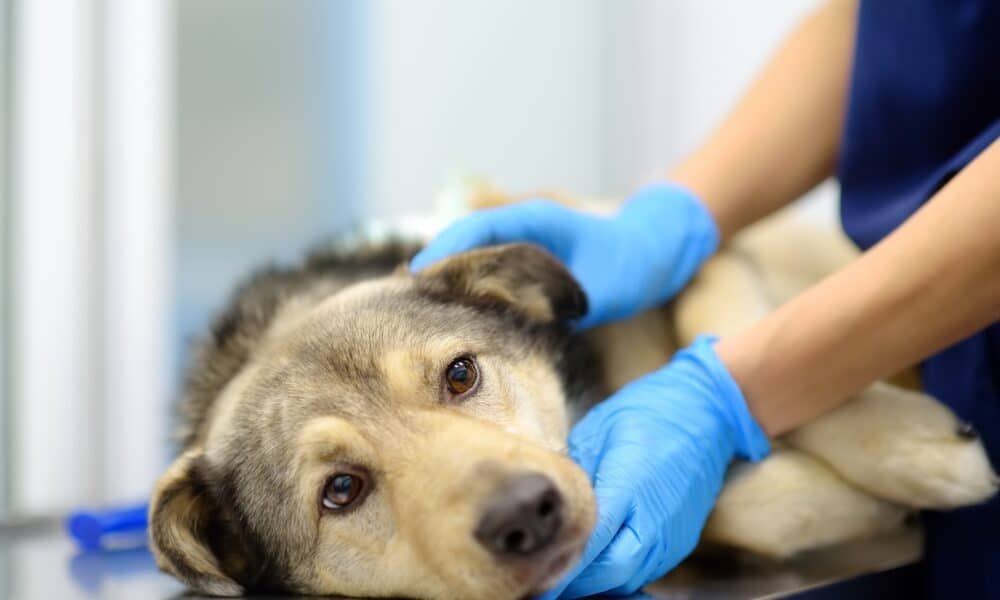A dog’s esophagus is a long, flexible muscular tube that connects the throat to the stomach. Its main function is to transport food and liquids from the mouth into the stomach for digestion.
It is also lined with a mucous membrane that protects it from acidic digestive juices and helps lubricate it for efficient food passage during digestion.

With such an important role, it can be a real problem when the canine esophagus’ lining is damaged or injured. This can lead to inflammation, known as esophagitis in dogs.
Esophagitis in dogs is more common than some people might think, but it can be tricky to recognize as signs and symptoms can vary from mild to severe.
In this article, we’ll help you better understand esophagitis in dogs, its causes, symptoms, diagnosis, and treatment.
What Is Esophagitis In Dogs?
Esophagitis in dogs is the inflammation of the esophagus, often caused by acid reflux, where stomach fluid flows back up into the esophagus, leading to irritation and inflammation due to acidity.
Esophagitis in dogs can be caused by ingesting foreign objects, certain medications, or as a secondary complication of various gastrointestinal issues.
Symptoms of Esophagitis In Dogs
Esophagitis in dogs presents a wide range of symptoms, from mild regurgitation to severe difficulties in swallowing, drooling, and fever.
Recognizing these symptoms can be challenging as they overlap with other health problems, but regurgitation is a common sign that differs from vomiting in key ways.
Causes Of Esophagitis In Dogs
Esophagitis in dogs can be caused by various factors, including foreign body ingestion, acid reflux, inflammatory bowel disease, and medications like doxycycline.
Diagnosis Of Esophagitis In Dogs

Diagnosing esophagitis in dogs involves a physical examination, laboratory tests, and possibly an endoscopy to assess the condition of the esophagus.
While plain radiographs do not help much in the diagnosis of esophagitis, an advanced type of radiography, called barium contrast radiography, can help diagnose and reveal changes in the esophagus if it really is inflamed.
In barium contrast radiography, barium sulfate is orally administered to the dog. When ingested, it will coat the inside of the dog’s gastrointestinal tract that will then help create a clear image on an x-ray.
Treatment Of Esophagitis In Dogs


Treatment of esophagitis in dogs will vary and depend on the underlying cause and the severity of the case.
If the esophagitis is caused by gastroesophageal reflux, then using medication (such as antacids) that decrease the amount of gastric acid the stomach procures will be prescribed.
The vet will also prescribe medication to coat, protect, and soothe the lining of the esophagus from the constant exposure to stomach acids. And depending on the severity, they may also prescribe antibiotics and pain medication to reduce any discomfort and eliminate any harmful bacteria.
Mild esophagitis may require no treatment at all. And for moderate cases, patients often recover with treatment after three to five days.
Furthermore, surgical treatment might be necessary if the esophagitis is caused by hernia or ingestion of foreign bodies. And in some severe cases, dogs need to be hospitalized for intensive care and treatment.
Recovering From And Managing Esophagitis In Dogs


Depending on the vet’s instructions, you will have to withhold water and food for a few days while your dog recovers. This means you’ll have to switch to intravenous nutrition during recovery.
And then when your dog is able to eat normally again, make sure to give them something that is soft and highly nutritious.
Furthermore, diet management will help the esophagitis heal. And your dog will need a low-fat prescription diet that helps lower the production of stomach acid.
Food should also be divided into a number of small meals throughout the day instead of one big meal to help reduce reflux in the esophagus.
To ensure that recovery is going well, make sure to take your dog to its follow up progress checkups. Sometimes, another endoscopy examination is needed during recover to ensure the the esophagus is responding well to medication and is healing properly.
Conclusion
A dog’s esophagus plays a crucial role in the digestive system, and any form of damage or issues affecting it can lead to significant health problems.
And while esophagitis is a common problem, it is often overlooked or mistaken for another issue. It can start mild, but delaying treatment can worsen your dog’s condition.
That’s why understanding the symptoms and causes and knowing how to prevent and manage it are all vital in ensuring that your dog stays healthy.
So, if you recognize any signs and symptoms, make sure to bring your dog to the vet for immediate diagnosis and treatment.
“Please make sure to arrive at the meeting on time.”
“Kindly ensure you are punctual for the meeting.”

